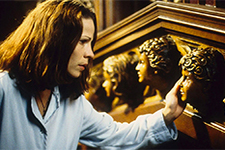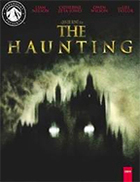The Haunting
|  When Jan de Bont’s The Haunting hit theaters in the summer of 1999, it had been a while since anyone has made an out-and-out haunted house movie. Not a jokey, campy ghoul fest ala Sean S. Cunningham’s House (1986) or Peter Jackson’s Hollywood debut The Frighteners (1996), but a straight-up, unironic, classical, fear-doused chiller. As a matter of fact, the only memorable ones I could think of in the prior 20 years were Stanley Kubrick’s The Shining (1980) and Tobe Hooper and Steven Spielberg’s Poltergeist (1982). It had been that long. And then, there came The Haunting, loosely adapted by screenwriter David Self (Thirteen Days, Road to Perdition) from Shirley Jackson’s classic 1959 novel (which had previously been filmed in 1963 by Robert Wise and later adapted into the 2018 Netflix mini-series by Mike Flanagan) and helmed by de Bont, the cinematographer-turned-action director responsible for the excellent Speed (1994), the mediocre Twister (1996), and the lackluster Speed 2: Cruise Control (1997). In making The Haunting, de Bont had two major hurdles to clear: First, he had to prove that his career was not, contrary to all evidence, in slow decline after his extraordinarily rapid ascent to the rank of first-tier action directors; and second, he had to prove that he could hold his own in an unfamiliar genre and withstand comparisons to other movies by directors like Kubrick and Wise. In short, he had a tall order to fill, and he came through—sort of. In its first half, The Haunting is a decidedly effective, spooky tale of tormented ghosts in a huge Gothic mansion. Unfortunately, the film soon loses its way as de Bont drops all pretenses of subtlety, ramps up the action, and allows the digital effects to run amok. The film tells the story of a group of people spending a week at Hill House, an enormous, 160-year-old mansion nestled away in the woods of northern New England. Dr. Jeffrey Marrow (Liam Neeson) brings three subjects to Hill House under the pretense that they are taking part in a study on insomnia when, in fact, Dr. Marrow is conducting research on the nature of fear. The three subjects, all of whom suffer from sleep disorders, are Eleanor Lance (Lili Taylor), a woman of low self-esteem who has spent her entire adult life taking care of her ailing, recently deceased mother; Theodora (Catherine Zeta-Jones), a sultry, adventurous New Yorker; and Luke Sannerson (Owen Wilson), a sarcastic young man who immediately introduces himself as a “tosser-turner.” But, if there is a truly memorably character in The Haunting, it is the house itself. Hill House is a marvel of production design, a $10-million set designed by Eugenio Zanetti (Restoration) that is as huge as it is almost overbearingly elaborate (it was constructed inside the same hangar where Howard Hughes built the Spruce Goose, and Harlaxton Manor in Nottinghamshire stood in for the numerous sweeping exterior shots). Combining everything from Victorian, to Gothic, to Baroque architecture (one character describes it as “sort of like Charles Foster Kane meets The Munsters”), Hill House features hidden passageways, towering ceilings, a grand staircase, and a mirrored room that serves as a giant carousel. It is decorated with floor-to-ceiling paintings, enormous statues of lions and gryphons, and—creepiest of all—the faces of hundreds of children carved into walls, headboards, and banisters. These children, whose echoing, disembodied voices create the most genuinely hair-raising shivers, haunt the house along with its builder, a terrible tyrant named Hugh Crain who harbors a dark secret. The human characters don’t fare nearly as well as the house, despite the fine line-up of actors. Neeson, then best known for heading the historical dramas Schindler’s List (1993), Rob Roy (1995), and Michael Collins (1996), is surprisingly ineffective, perhaps because his character doesn’t have much to do except bring the subjects to the house and then appear when he’s needed. Zeta-Jones once again plays a sexy siren, and, to her credit, she gives Theo more spunk and life than the character probably deserves. Owen Wilson is mostly annoying as Luke, a truly grating character if ever there were one; his main purpose seems to be making lame jokes and blurting out the obvious (“The staircase is falling!”). It is only Lili Taylor , who at the time was known mainly for her roles in indie films like Abel Ferrara’s The Addiction (1995) and Mary Harron’s I Shot Andy Warhol (1996), who truly gets a character to play. With the exception of a brief, dull scene involving Dr. Marrow explaining his project to a supervisor, Eleanor is the only character we get to see outside of the clutches of Hill House. It gives her an added dimension that works not only in terms of plot explication, but also in making her more interesting and understandable. The Haunting is at its best when it is working in a more subtle register, generating chills and suspense with atmosphere and sound effects alone. In many respects, sounds are much scarier than visuals because they only suggest what is out there. When faced with a terrible creature, it may be horrifying, but at least you know what you’re up against. To only hear the terror scraping outside the door or moving through the walls, creating that awful, gut-churning anticipation of what’s to come, is infinitely more unnerving. Some of the visuals in The Haunting do work, however: a few digital effects of ghostly children billowing in the drapes or crawling under sheets work nicely, as does another scene where a pair of windows turn into glowering eyes. But, since this the film was released during summer blockbuster season, a major, outrageous finale was in order, and de Bont delivered one that is as visually audacious as it is utterly nonsensical—a fitting capstone on a film that is too long and muddled for its own good (the overwhelming nature of the house’s ornate interiors provide a nice metaphor for the film’s desperation to immerse us in its world). Although there are some genuinely creepy moments and jump-in-your-seat shocks, it is the overkill that we remember in the end. It is not quite detrimental enough to completely undo the better, more restrained work that went into the first half of the film, but it does leave you frustrated and wondering what might have been.
Copyright © 2020 James Kendrick Thoughts? E-mail James Kendrick All images copyright © Paramount Home Entertainment | |||||||||||||||||||||||||||||
Overall Rating: 

 (2.5)
(2.5)


